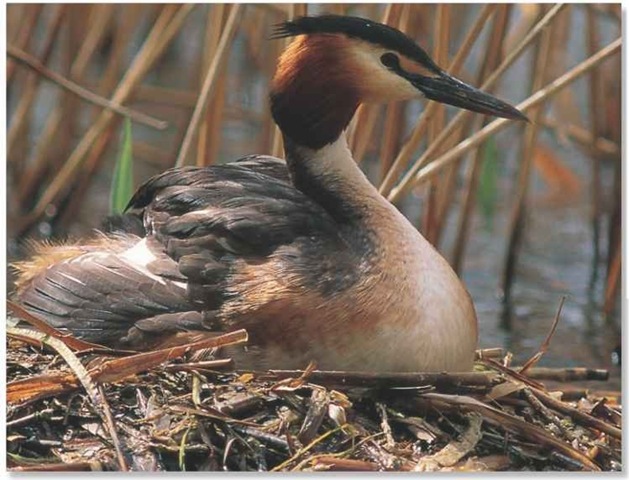ORDER
Podicipediformes
FAMILY
Podicipedidae
GENUS & SPECIES
KEY FEATURES
• Pursues prey underwater, propelled by rear-set legs with lobed feet for maximum driving power
• In the breeding season, both sexes grow elegant crest feathers for elaborate, ritualized displays
• Builds a floating nesting platform out of aquatic vegetation on clean lakes, rivers and reservoirs
WHERE IN THE WORLD?
On freshwater and coasts across parts of Europe and central Asia as far east as China; also in southern and eastern Africa, New Zealand and Australia

Lifecycle
Rarely if ever leaving water, except to fly between different feeding areas, the elegant great crested grebe is highly efficient at catching fish in its own element.
Habitat
Quiet lakes and large ponds circled by aquatic vegetation and slow-moving rivers with pools and backwaters provide the great crested grebe with ideal habitat.
The bird has taken to many man-made aquatic habitats, such as ornamental lakes, ponds and reservoirs. Outside the breeding season, it may inhabit estuaries and coastlines.
In Africa and New Zealand, the grebe lives on high-altitude lakes, even tolerating harsh conditions, such as choppy waves and ice-bound water.
The grebe needs open, clean water with a plentiful stock of fish, invertebrates, amphibians and insects, which provide essential food supplies.
Quiet backwater
Tranquil reed-fringed lakes are ideal habitat.
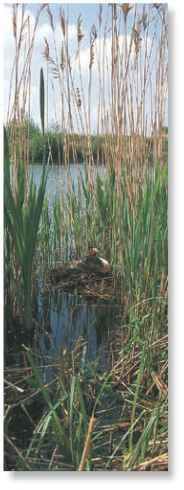
Grebes are among the oldest and most primitive of all groups of birds: fossils of their ancestors from 80 million years ago have been discovered.
Grebes eat large amounts of their own feathers. The feathers slowly decompose and line the stomach — probably to protect it from injury by sharp fish bones.
Behavior
The elegant, stately appearance of the grebe belies its nature. It can be extremely aggressive, especially near the nest, and attacks any intruder that comes too close. Outside breeding seasons, the grebe becomes more sociable and sometimes joins others of its kind to form large flocks in winter. On the Black Sea coast in Turkey as many as 20,000 grebes congregate. At other times of the year; it’s usually solitary.
Maintaining its plumage in waterproof condition occupies a great deal of the bird’s time. After feeding, it preens itself meticulously, using its bill to spread oil from a gland at the base of the tail through its feathers.
Food & feeding
The grebe’s long, slim neck and pointed bill are used for catching fish underwater. At least 20 species of freshwater fish, including eels, make up its diet in Europe. When it moves to sea coasts in winter, it also feeds on many sea fish species. An individual may eat 5-7 oz. of fish a day, supplemented by a variety of invertebrates, such as snails and crustaceans — especially crayfish and shrimps. In the breeding season, insects also are an important par t of the diet.
The grebe dives underwater to search for prey. It may remain underwater for up to 30 seconds and normally dives to about 17′. When it spots a fish, it accelerates in pursuit, twisting with the fish’s every movement until it’s close enough to strike with its bill.
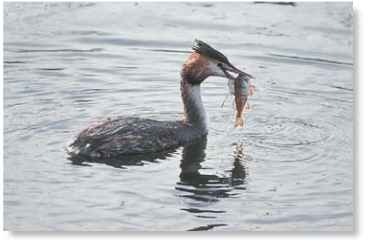
A Expert fisherman
Fish caught underwater are gulped headfirst at the surface.
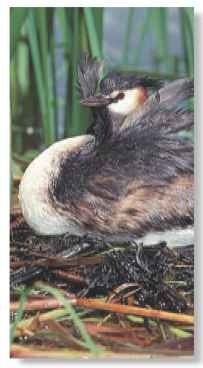
Conservation
In the 19th century, the great crested grebe was hunted for its head plumes and breast feathers, almost to extinction in many parts of Europe. More recently, by taking advantage of man-made waters, the species has recovered well and isn’t currently in any danger. However, extensive gill-net fishing on some lakes in East Africa has led to its disappearance from many places there.
TO the point
The fine bill is ideal for catching and holding fish.
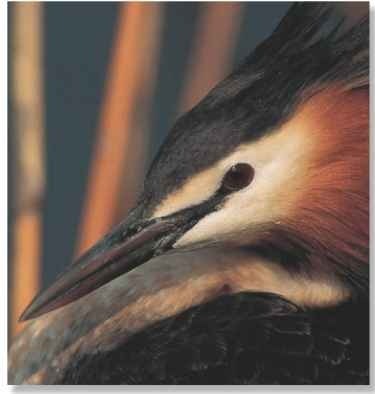
Breeding
In the breeding season, the grebe performs complex displays using its ornate head plumes in head- and bill-shaking and ritualized “dances.” These displays strengthen each pair’s bond.
Both sexes build the nest (a floating platform of aquatic plants anchored to surface vegetation). The female lays
3-5 eggs and the down-covered, black-and-white-striped chicks hatch about four weeks later: They’re carried away from the nest on their parents’ backs, nestled in their warm feathers.
Almost at once, the chicks can dive and, if threatened, remain totally submerged except for the bill tip. When the chicks are six weeks old, the parents divide their brood and each adult feeds and protects half the chicks.
ceremony of the weeds
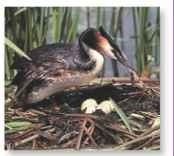
A Water bed
The nest rises and falls with the water level.
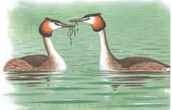
Let’s dance…
Perfectly synchronized, the male and female dive together and then resurface, each carrying a clump of aquatic weed in its bill.
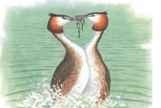
Mutual embrace…
The birds move toward one another and suddenly rise up, almost touching breast-to-breast, treading water to keep position.

Shaking of the heads…
The ceremony reaches its climax with both birds elegantly rocking their heads from side to side in a beautiful, swaying dance.
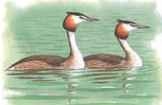
Performance over
With the ritual complete, the birds flatten their crest and fan feathers. They settle back on the water and swim off side by side.
PROFILE
Great Crested Grebe
A fast and agile swimmer both on the water surface and beneath it, the great crested grebe is designed for high-speed pursuit of aquatic prey.
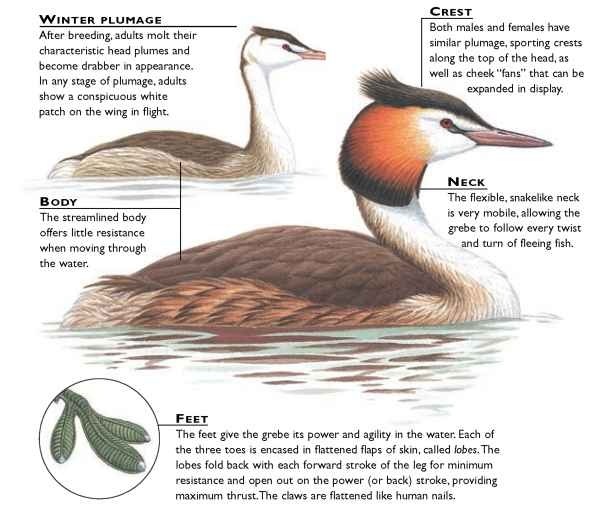
Creature comparisons
The great crested grebe, like many grebes, has head feathers in the form of crests, ruffs or tufts for breeding displays. Several species also have bright decorative plumes behind the eye which contrast with the color of the rest of the head, as in the eared grebe, Podiceps nigricollis, of North
America and Europe.The horned grebe, P auritus, which occurs across the north of the same two continents, has elongated golden tufts lying along each side of a black head.

| VITAL | |
| STATISTICS | |
| Weight | 1-3 lbs. |
| Length | 18-24″ |
| Sexual Maturity | 2 years |
| Breeding f Season | April-July in Europe; year-round in Africa; Nov.-March in Australia |
| Number of Eggs | 1-7; usually 3-5 |
| Incubation 25-31 days [ Period | |
| Fledging Period | 71-79 days |
| Breeding iInterval | 1 year |
| Typical [ Diet | Small fish, frogs, tadpoles, crayfish, insects, mollusks |
| Lifespan | Up to 15 years |
RELATED SPECIES
• There are 21 grebe species in five genera. The little grebe, Tachybaptus ruficollis (below), also called the dabchick, eats invertebrates and has a short and sturdy bill. Fish-eating grebes, such as Clark’s grebe, Aechmophorus clarkii, have long, pointed bills.

